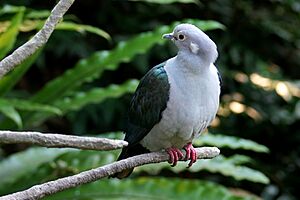Green imperial pigeon facts for kids
Quick facts for kids Green imperial pigeon |
|
|---|---|
 |
|
| Conservation status | |
| Scientific classification | |
| Genus: |
Ducula
|
| Species: |
aenea
|
| Synonyms | |
|
|
The green imperial pigeon (Ducula aenea) is a large, colorful pigeon that lives in forests. It has a very wide home range. You can find it from Nepal, southern India, and Sri Lanka in the west. Its range goes eastwards to southern China, Indonesia, and the Philippines.
Contents
How the Green Imperial Pigeon Got Its Name
Scientists give every living thing a special two-part name. This is called binomial naming. It helps everyone around the world know exactly which animal or plant is being talked about.
In 1760, a French scientist named Mathurin Jacques Brisson wrote about this pigeon. He gave it a long Latin name. Later, in 1766, the famous Swedish scientist Carl Linnaeus gave it a shorter, official name: Columba aenea. Linnaeus is known for creating the system we use today to name species.
The word aenea comes from Latin. It means "of a bronze color" or "coppery." This describes the pigeon's beautiful metallic feathers. Today, this pigeon is placed in the group, or genus, called Ducula.
Different Types of Green Imperial Pigeons
Just like there are different breeds of dogs, there are different types of green imperial pigeons. These are called subspecies. They are slightly different depending on where they live.
Here are some of the recognized subspecies:
- D. a. sylvatica – Found from north India and Nepal to south China.
- D. a. pusilla – Lives in south India and Sri Lanka.
- D. a. andamanica – Found in the Andaman Islands.
- D. a. consobrina – Lives on islands west of Sumatra.
- D. a. polia – Found from the Malay Peninsula to the Sunda Islands.
- D. a. palawanensis – Lives from north Borneo to Palawan in the Philippines.
- D. a. fugaensis – Found in the northern Philippines.
- D. a. nuchalis – Lives in northern Luzon in the Philippines.
- D. a. aenea – The main type, found in most of the Philippines.
- D. a. intermedia – Lives in the Talaud Islands and Sangihe Islands.
- D. a. paulina – Found in Sulawesi and nearby islands.
Sometimes, one of these subspecies, D. a. oenothorax, is thought to be its own separate species.
What Does the Green Imperial Pigeon Look Like?
The green imperial pigeon is a big, plump bird. It can be about 45 centimeters (about 18 inches) long. Its back, wings, and tail are a shiny, metallic green color.
Its head and belly are white. However, the feathers under its tail are a deep maroon color. Both male and female pigeons look very similar. You might hear its deep, booming call before you even see the bird high up in the trees.
Where Do Green Imperial Pigeons Live?

This pigeon loves forests. It lives across tropical southern Asia. Its home stretches from Nepal and India in the west, all the way to Indonesia in the east. It is a common bird in these areas.
One special type, the chestnut-naped imperial pigeon (Ducula aenea paulina), lives in Sulawesi.
Life and Habits of the Green Imperial Pigeon
This pigeon spends most of its time in trees. It eats plants and fruits found in the tree canopy.
Flight and Movement
When it flies, it is very fast and flies in a straight line. Like most pigeons, it flaps its wings regularly. Sometimes, it gives a quick, sharp flick of its wings.
Reproduction and Nesting
The green imperial pigeon builds a nest out of sticks in a tree. The female pigeon usually lays just one white egg. These birds are not usually found in very large groups. However, they might form small flocks when looking for food.
Images for kids






